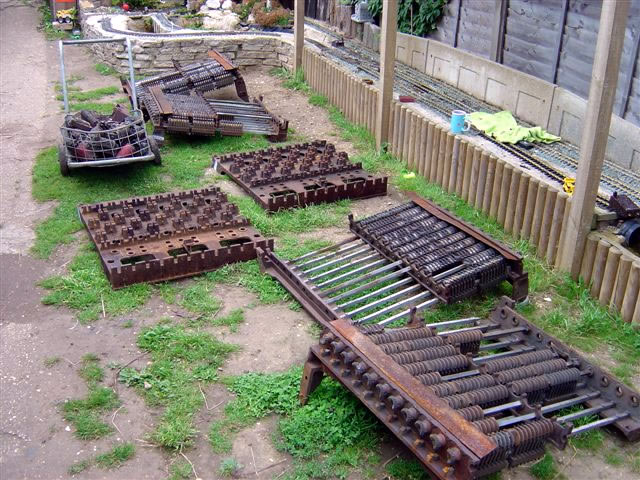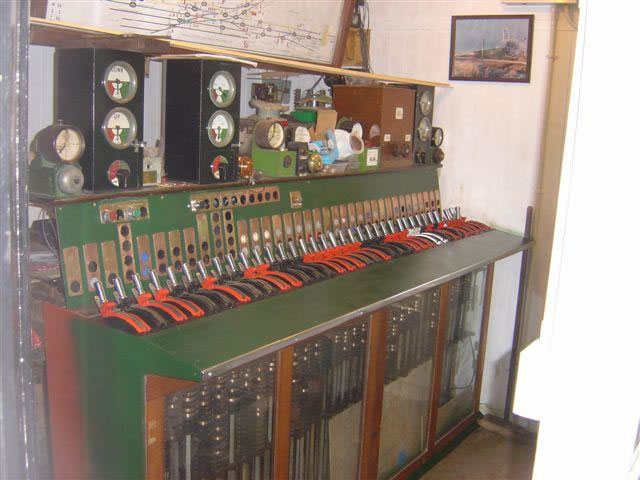Every so often I mention the Westinghouse Brake and Saxby Signal Company which was the result of the British Commonwealth's Westinghouse Brake Company purchasing the then dominant UK railway signaling supplier Saxby and Farmer in 1901. For those of you who are unaware, George Westinghouse's claim to fame was the invention of the automatic railroad air brake and he set up corporate entities in both the US and overseas to market his produce. In an early example of corporate synergy, Westinghouse also became involved with railway signaling, either directly producing signaling hardware or owning a signaling subsidiary in many markets. Because there is little sense in reinventing the wheel, the Westinghouse corporate empire would cross-license signaling technology between its various arms. This is how US&S became the supplier of the Improved Saxby and Farmer type mechanical lever frame in the United States and how WB&SS Co would come to sell a power interlocking machine awfully similar to what would become the Model 14 family sold by US&S.
 |
| Balham Signalbox Style L Power Frame |
As railway signaling moved from purely mechanical to incorporate automatic blocks, electric signals and power operated point machines, interlocking machines effectively became hybrids with both mechanical and electric locking. 19th century mechanical methods would continue to provide the route locking, while magnets and solenoids would lock the levers electrically based on track or switch position circuits.
 |
| Electric locks on a traditional "armstrong" type lever frame. |
Since safety critical railway signaling relays were quite expensive, signaling suppliers had an incentive to carry out as much logic as possible in the mechanical layer. Therefore even "power" interlocking machines like the GRS pistol grip style or US&S crank lever style still made use of miniaturized mechanical locking grids.
Westinghouse owned Union Switch ad Signal had already been the North American licensee of the Improved Saxby and Farmer mechanical locking system and has been using it in its crank style power interlocking machines since the 1890's. In 1901 the newly minted Westinghouse Brake and Saxby Signal Company was suddenly in a position to employ US&S's innovations in Commonwealth countries and came out with its Styles A and B interlocking machines, localized for British signaling tastes.
 |
| WB&SS Co Miniature Lever Frame in British Service |
Like the crank (ie "Model 14") style interlocking machines in North America, the Westinghouse power frames had three distinct logical components inside the box. First, a mechanical locking grid of the S&F type handling route locking. Second, locking magnets that would lock lever travel based on the state of the electric relay logic. Third, electric contact spindles that would make or brake electric circuits depending on the position of the lever.
 |
| Style K frame with mechanical locking grid. |
 |
| Style K frame contact spindles. |
A route conflict would result in a hard lock as steel bits in the locking grid would physically block movement. An electric problem like points out of correspondence or an occupied track circuit would create a soft lock as the lever was stopped by magnetic latches interacting with a rocker arm on the lever spindle. Anyone who has visited HARRIS tower and its functional Model 14 knows the difference in feel between hard and soft.
 |
| Magnetic "soft" locks on a Model 14 machine. |
All of this was fine until 1929 when the 23 ton weight of 311 lever London Bridge Style K interlocking machine made Westinghouse Brake and Signal question the sustainability of the technology. Unlike North American pattern machines, the British pattern was less lever efficient, needing more physical levers to carry out the same functions. This not only created a weight problem, but also a size problem as the locking grid dimensions grew literally by the square of the lever count. While American railroads had the space to build beefy towers with wide dimensions, the "early adopter" British railways had harder clearance constraints, especially in major cities where large power frames were most likely to be built. For example the aforementioned London Bridge signal box had to orient its locking bed vertically, making the tower an extra floor taller.
 |
| London Bridge Signalbox |
The solution to this was the Style L frame. Externally the Style L looks exactly the same as the Style K, however internally it is quite different with the mechanical locking grid being completely done away with and replaced by electric locking. the Style L existed as yet another step between the purely mechanical interlockings of the 19th century and the all-relay plants that would ascend in the 1950's. However for anyone wondering why an electrically interlocked plant would even bother with clunky miniature levers, there are some advantages. First it maintains a familiar UI and reuses many of the components that were already in production. Second, it still reduces the number of high cost safety critical railroad relays. The latter is not entirely obvious, but an electro-magnet that unlock a contact spindle that a human then turns, is performing many of the same functions as a vital relay without the same need for precision manufacturing. The website covering Westinghouse power frames has both patent and part information so I'll leave digging down into the fine details of how this electric locking was carried out as an exercise to the reader.
 |
| Style L parts |
 |
| Style L restored |
 |
| Style L relay locking logic |
The Style L completely displaced the mechanically locked style B and K frames on the main line UK rail network with a burst of new deliveries being made to the British Rail Southern Region between 1948 and 1953. Additional frames were delivered to South Africa up until 1960 with a final BR frame delivered in 1962. An interesting ramification of the Style L all-electric logic was a far greater degree of adaptability than those with mechanical locking. In North America, all railroads (except naturally the PRR) had to hire US&S to perform major modifications to the mechanical locking grid. However the Style L electric locking could be modified without the need for specialized tools and British Rail was able to manufacture quite a few "new" Style L plants using left over components or even spare frames obtained for redundancy purposes during World War 2. Even after retirement from main line service, both heritage and miniature railways have been able to adapt surplus Style L equipment for their own track layouts.
The final act of the Westinghouse power frame would play out on London Transport in the form of the mechanically locked Style N and Style V frames as their modest lever counts and subterranean placement didn't trigger the same sort of weight issues seen on the main line railroads. In fact, the last Style V frame, think a Model 14 automated by pneumatic actuators) was installed on LT in 1993! (Which goes to show just how wedded the British were to mechanical technology.) With the closure of Wellington A Signalbox earlier in 2025 and Liverpool Lime St in 2018, the last active Style L outside of preservation might be the signalbox at Maidstone East, which was fittingly the last new built Style L delivered in 1962.



